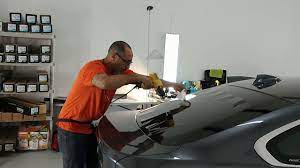Window tint can either be applied to the exterior of a surface or the interior. The main difference between these two methods is the adhesive used to secure the film. Exterior window tints are usually held in place by an acrylic-based glue, which provides a longer-lasting and more durable hold, but can be harder to remove than film that’s adhered with a wax-based adhesive.
Interior film, on the other hand, is attached on the side of your car window that faces into your vehicle. This method tends to provide a better aesthetic result than exterior film (as it lacks an unsightly adhesive layer), plus it’s much easier and less expensive to install when you don’t have to pay someone else to do it. Interior window tint generally lasts three years before requiring replacement.
What is window tint?
Window tinting is the process of applying a film to the glass in your car that protects you and your interior from three of the biggest elements: sun, heat, and glare. It increases privacy, helps keep upholstery intact in case of an accident, and can even protect you from UV rays.
It’s good to be informed about all the different types of window tinting so you can choose which one best suits your needs. Some are better at reducing sunlight than others; some offer more privacy but less protection against shattered glass; some are more durable than others. There are many options out there depending on what you’d like to accomplish with lightweight film on your windows.
The difference between exterior and interior window film
There are two basic categories of car window film: exterior window film and interior window film. Exterior window films are applied on the outside surface of your windows, while interior films are installed on the inside.
The primary benefit provided by exterior films is their durability—an exterior film can last up to 15 years or more without needing to be replaced. It’s also easier to replace an exterior film than an interior one, as you won’t have to worry about breaking the seal of your tint while you’re trying to install a new layer.
Exterior films are also better at protecting against UV rays, as they filter out 100 percent of UV radiation from sunlight, whereas interior films block only 80 percent. However, this benefit doesn’t necessarily outweigh the benefits offered by interior films in light of their other advantages (cost-effectiveness and heat rejection).
How to apply window film
In order to correctly apply window film, you should first make sure that the window is clean and dry. If there is any dirt or grime on the surface of the window, it will get trapped inside of your tint when applied. Next, measure and cut your film to size so that it matches up with the dimensions of your car windows.
When applying tint to smaller windows, like those found in automobiles, it can be helpful to use a spray bottle filled with just a bit of water (distilled water is best). Spray both the outside of the window and the adhesive side of your pre-cut tinting film before sticking them together. As you’re positioning your window film onto its designated glass surface, use something flat and smooth—like a credit card or a squeegee—to push out any air bubbles that may have gotten trapped during application.
Finally, make sure to apply firm pressure around all edges since this will help prevent peeling over time.
How long does car window tint last?
Will car window tint last? You’ve probably heard that window tint can last for a long time. But how much of that is hype and how much of it is fact?
The honest answer is that it’s true: High-quality car tint can last for several years if properly maintained. Those years aren’t just hypothetical, either—there are many drivers who report keeping their window film on the same vehicle for 5 to 7 years or longer! There are also plenty of drivers who report facing issues after a few months.
Why does longevity vary so wildly? Like all things in life, there are factors at play each step of the way that affect your results. Considering those factors starts with a basic understanding of what makes up your average roll of auto tinting film.


